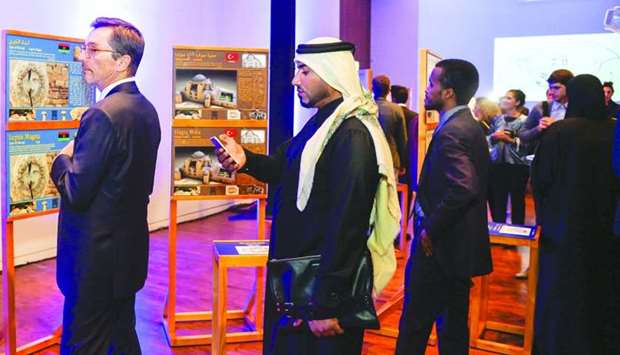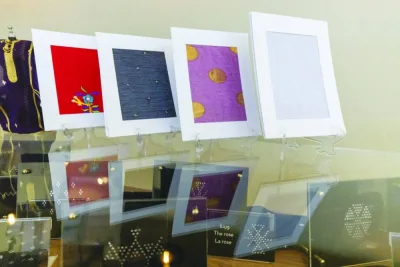The ArcheoMed3D Exhibition was launched Tuesday at Msheireb Museums' Jelmood House, showcasing various Unesco-listed World Heritage Sites in the Mediterranean Basin, the Middle East and Arabian Gulf.
A panel discussion highlighted the event while the 3D interactive exhibition will be open to the public at Company House from Wednesday until March 9.
"The exhibition aims to promote dialogue and enhance cultural exchanges within countries of the Mediterranean Basin, the Middle-East and the Arabian Gulf, underlining the extraordinary cultural variety and inputs that this part of the world has absorbed over history," Italian ambassador Pasquale Salzano said.
He noted that this unique show is formed by panels dedicated to the history of a meaningful selection of archaeological wonders.

The exhibition uses the latest technology in archaeological 3D visualisation and augmented reality to bring to life these sites from around the world, and "raise awareness on our common world heritage."
Salzano said Italy and Qatar share the same vision about culture and knowledge: they belong to all humankind and they have no boundaries.
"The impressive number of countries represented in the ArcheoMed 3D exhibition confirms this vision. Cultural Heritage indeed represents our past, but it also expresses what we have in common in the present and what we want to preserve for the future," he stressed.
ArcheoMed 3D aligns with the commitment of Msheireb Museums to innovation and ingenuity in making history and culture a sensory experience that is both inspiring and tangible.
“Msheireb Museums prides itself in partnering with global organisations that share a similar vision to ours. Working in tandem with the embassy of Italy in Qatar and Unesco is another way to diversify our offering to the public and create a platform for intercultural dialogue that promotes tolerance and understanding across nations," Msheireb Museums director Dr Hafiz Ali Abdulla said.
Comprising of a series of didactic panels, the exhibition features two main technologies; barcodes and augmented reality.
Visitors will be able to scan barcodes using their smartphones in order to view the 3D film visualisation of the archaeological sites. Augmented reality can be viewed via an exhibition app, which will enable visitors to scan the panels to reveal 3D augmented reality models.
Anna Paolini, director of the Unesco Regional Office in Doha, said documentation of cultural heritage is an essential element of the restoration and restitution process.
"The 3D virtual rendering of archaeological sites or historic cities based on scientific documentation allows us to visualise how they used to look like in a precise period in time," she noted.
"That’s why, ArcheoMed allows us to explore and appreciate some of the most important World Heritage sites around the Mediterranean basin and in the Middle East at the moment of their glory," Dr Paolini added.
ArcheoMed 3D is organised by the embassy of Italy in Doha and Msheireb Museums, in co-operation with Unesco Regional Office in Doha and Altair4. It is sponsored by the Italian Foreign Ministry.
"The exhibition aims to promote dialogue and enhance cultural exchanges within countries of the Mediterranean Basin, the Middle-East and the Arabian Gulf, underlining the extraordinary cultural variety and inputs that this part of the world has absorbed over history," Italian ambassador Pasquale Salzano said.
He noted that this unique show is formed by panels dedicated to the history of a meaningful selection of archaeological wonders.

Msheireb Museums director Dr Hafiz Ali Abdulla

Italian ambassador Pasquale Salzano

Unesco Regional Office in Doha director Dr Anna Paolini
These countries include Italy (Temple of Zeus in Agrigento and the archaeological site of Pompeii), Qatar (Al Zubarah), Morocco (Volubilis), Tunisia (El Jem), Algeria (Djémila), Syria (Krak des Chevaliers), Palestine (Church of the Nativity in Bethlehem), Lebanon (Baalbek), Turkey (Hagia Sophia), Jordan (Petra), and Libya (Leptis Magna), among others.
Italian ambassador Pasquale Salzano

Unesco Regional Office in Doha director Dr Anna Paolini
The exhibition uses the latest technology in archaeological 3D visualisation and augmented reality to bring to life these sites from around the world, and "raise awareness on our common world heritage."
Salzano said Italy and Qatar share the same vision about culture and knowledge: they belong to all humankind and they have no boundaries.
"The impressive number of countries represented in the ArcheoMed 3D exhibition confirms this vision. Cultural Heritage indeed represents our past, but it also expresses what we have in common in the present and what we want to preserve for the future," he stressed.
ArcheoMed 3D aligns with the commitment of Msheireb Museums to innovation and ingenuity in making history and culture a sensory experience that is both inspiring and tangible.
“Msheireb Museums prides itself in partnering with global organisations that share a similar vision to ours. Working in tandem with the embassy of Italy in Qatar and Unesco is another way to diversify our offering to the public and create a platform for intercultural dialogue that promotes tolerance and understanding across nations," Msheireb Museums director Dr Hafiz Ali Abdulla said.
Comprising of a series of didactic panels, the exhibition features two main technologies; barcodes and augmented reality.
Visitors will be able to scan barcodes using their smartphones in order to view the 3D film visualisation of the archaeological sites. Augmented reality can be viewed via an exhibition app, which will enable visitors to scan the panels to reveal 3D augmented reality models.
Anna Paolini, director of the Unesco Regional Office in Doha, said documentation of cultural heritage is an essential element of the restoration and restitution process.
"The 3D virtual rendering of archaeological sites or historic cities based on scientific documentation allows us to visualise how they used to look like in a precise period in time," she noted.
"That’s why, ArcheoMed allows us to explore and appreciate some of the most important World Heritage sites around the Mediterranean basin and in the Middle East at the moment of their glory," Dr Paolini added.
ArcheoMed 3D is organised by the embassy of Italy in Doha and Msheireb Museums, in co-operation with Unesco Regional Office in Doha and Altair4. It is sponsored by the Italian Foreign Ministry.




